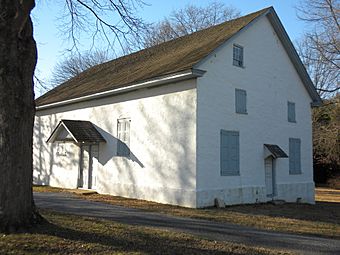Old Kennett Meetinghouse facts for kids
Quick facts for kids |
|
|
Old Kennett Meetinghouse
|
|

Old Kennett Meetinghouse, December 2009
|
|
| Location | South of West Chester on U.S. Route 1, east of its junction with Pennsylvania Route 52, Kennett Square, Kennett Township, Pennsylvania |
|---|---|
| Area | 4 acres (1.6 ha) |
| Built | 1710 |
| NRHP reference No. | 74001776 |
| Added to NRHP | July 15, 1974 |
The Old Kennett Meetinghouse is a very old and important building. It is located in Kennett Township, near Chadds Ford, Pennsylvania. This historic building was built by the Religious Society of Friends, who are also known as "Quakers." It has been a special place for worship and community gatherings for hundreds of years.
Contents
The History of Old Kennett Meetinghouse
Building a Quaker Home
The Old Kennett Meetinghouse was first built in 1710. It was constructed on land that belonged to Ezekiel Harlan. This land was originally given by William Penn, who founded Pennsylvania. Many Quaker families were settling in the Kennett and Marlboro Townships at this time. They needed a place to meet.
Quakers from Kennett, Marlboro, New Castle, Hockessin, and Centre Meetings would gather. They met every four to six weeks for important business meetings. These meetings first took place at Newark Meeting. Over time, the Newark Meeting became smaller. So, the groups decided to meet at the Old Kennett Meetinghouse instead. In 1760, the name officially changed from Newark to Kennett.
A Place in the American Revolution
During the American Revolutionary War, the Quakers tried to stay neutral. This meant they did not pick a side in the fight. However, the Old Kennett Meetinghouse still played a role in the war.
On September 11, 1777, the first shots of the Battle of the Brandywine were fired here. British and Hessian soldiers, about 5,000 strong, marched from Kennett that morning. A small American force, led by General Maxwell, was surprised. They were pushed back to the north hills of Chadds Ford. Soldiers who died in the battle that afternoon are buried in the Old Kennett Cemetery next to the meetinghouse.
Changes and Divisions Over Time
In the 1800s, the Kennett Meeting faced some challenges. The first change happened in 1812. A new Kennett Meeting was formed inside the town of Kennett Square.
Later, in 1827, the Friends group split into two main parts. One group was more traditional, and the other was more liberal. By 1828, there were separate Kennett Monthly Meetings. The liberal group, called the Hicksites (named after Elias Hicks), kept the Old Kennett Meetinghouse. The more traditional Friends built a new place called Parkersville Friends Meetinghouse. They used it until 1904.
Fighting for Freedom
Quakers had freed their enslaved people even before the American Revolution. They worked hard to change laws about slavery. Some Quakers wanted to hold public meetings against slavery at the Meetinghouse. However, not everyone agreed.
This disagreement led some "progressive" Friends to leave. They formed their own meeting and built the Longwood Meeting House. These progressive Friends were not officially recognized by the main Quaker group until 1874. The meetinghouse was a place where many important people visited. These visitors included Lucretia Mott, William Lloyd Garrison, Sojourner Truth, Susan B. Anthony, and Harriet Tubman. These were all famous people who worked to end slavery and fight for equal rights.
The Meetinghouse Today
Over time, the number of members at Old Kennett Meeting became very small. By the early 1920s, sometimes only one or two people would attend worship services.
Since 1950, a special committee from the Kennett Meeting (in Kennett Square) has taken care of the building. They open it for worship services on the last Sunday of June, July, and August at 11 a.m. In July 1974, the Old Kennett Meetinghouse was added to the National Register of Historic Places. This means it is recognized nationally as an important historical and architectural building.
In 2010, the meetinghouse celebrated its 300th birthday! They held special talks and historical tours. Today, the meetinghouse is still open for Quaker worship on the last Sundays of June, July, and August at 9:00 a.m. It is also used for weddings, funerals, and other special events.



